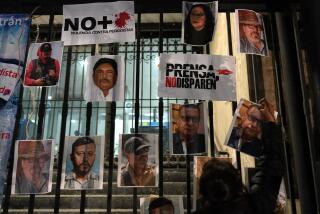Reporters covering Mexico drug wars risk their lives
- Share via
VILLAHERMOSA, MEXICO — Rodolfo Rincon had reason to feel cheery when he left his newspaper office on a January evening last year.
His report on drug dealing in coastal Tabasco state had made a splashy, two-page spread that day in the Tabasco Hoy.
That night, Rincon, considered one of the best police reporters in the state, had put the finishing touches on a story about ATM thieves for the next day’s edition.
He strode from the glassy newsroom and hasn’t been seen since.
Colleagues believe Rincon, 54, was captured, and probably killed, by drug traffickers aggrieved by his crime coverage. He is among more than 30 reporters killed or missing in Mexico since 2000 as drug violence has skyrocketed, according to Paris-based Reporters Without Borders.
In many ways, Mexico’s democratic evolution has afforded the news media greater freedom than at any time in modern history. But at the same time, reporters are working on a battlefield: Mexico is considered the most dangerous Latin American nation in which to be a journalist, and one of the riskiest in the world.
“Every day it’s more difficult to practice journalism in Mexico, especially from the middle of a war between the government and narcos,” said Ricardo Ravelo, a reporter at the national weekly magazine Proceso who covers drug trafficking. “We are in a no man’s land.”
Besides the killings and disappearances of reporters, criminal gangs have attacked newspaper offices with high-powered rifles and grenades. Anonymous threats are commonplace. Reporters have been seized, held for hours and beaten.
Journalists who want to report on crime are increasingly forced to weigh the risk of retribution by gangsters employing ever more gruesome methods.
In early June, for example, someone propped a severed head in front of a newspaper here accompanied by a handwritten threat against its director, Juan Padilla.
The newspaper, El Correo de Tabasco, had recently run numerous front-page stories and photographs about drug gangs, including an erroneous report that a top gunman in Tabasco for the so-called Gulf cartel had been captured.
When a second threatening note appeared at the same spot two days later, Padilla fled the country. His reporters now steer clear of the drug story, arguably the dominant topic in Mexico.
“We’re not going to cover it,” a veteran police reporter said. “We’ll cover weddings, quinceañeras and baptisms.”
News organizations, especially those along the border with the United States and in other drug hot spots, must navigate a minefield of potential hazards. Increasingly, Mexican journalists say, they withhold details about crimes unless provided in official statements by police or prosecutors. Some newspapers have stopped mentioning drug trafficking groups by name.
In Nuevo Laredo, a border city where drug gangs have battled ferociously for dominance, one newspaper editor acknowledged privately that it was safer to leave out details so no crime boss would think that coverage showed his side losing.
Other times, in a macabre twist on public relations, journalists have been pressured to publicize decapitations or other violent acts. Drug gangs view such publicity as a way to scare rivals and enhance their own standing in the underworld.
Self-censorship by news organizations means residents have to rely on the grapevine to find out what is going on in their communities.
“If there is a gunfight in the middle of the street and hundreds of people witness it, there is no assurance you’ll read about it in the next day’s newspaper,” said Joel Simon, executive director of the Committee to Protect Journalists.
The New York-based group has pushed for a law that would treat violations of free expression as a federal crime. Currently, cases involving violence against journalists are usually handled by authorities at the state level. They seldom result in arrests or prosecution.
Two years ago amid escalating attacks, Mexico’s federal government created a special prosecutor’s office to investigate crimes against journalists. But media advocates say it has accomplished little because it is barred from pursuing drug cases and often has to wait for state officials to act first.
Media defenders say the best protection may be better journalism. Some journalists, who are generally poorly paid, have been bought off or coerced into supporting a particular crime group through what they choose to publish in their reports or leave out.
But reporting that is honest, well-grounded and impartial can shield journalists against perceptions of favoritism, which often invite trouble, media advocates say.
“We don’t opt for silence. We opt for being rigorous,” said Ravelo of Proceso magazine, which tracks the drug story closely. “We don’t shut up. We prepare better.”
In Villahermosa, discretion remains the better part of valor.
At Tabasco Hoy, a four-person team of crime reporters works under a sign that says “Justicia.” Nearly 18 months after Rincon’s disappearance, his computer still contains his working files, brimming with tidbits about the drug trade and hit men.
But the newspaper’s rules of conduct have changed, said team leader Roberto Cuitlahuac, 45, a seasoned reporter with close-cropped hair and a photographer’s vest.
Stories about organized crime now omit the reporter’s name, a precaution becoming common among Mexican papers. And there is a level of fear among his colleagues that didn’t exist before Rincon vanished, Cuitlahuac said.
A night earlier, he said, one of his reporters refused to cover a fatal shooting because she was afraid. Cuitlahuac had to call on someone else. But he understood.
More to Read
Sign up for Essential California
The most important California stories and recommendations in your inbox every morning.
You may occasionally receive promotional content from the Los Angeles Times.










